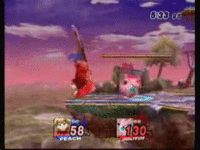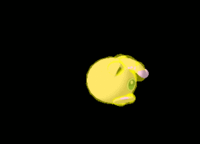Wall of pain: Difference between revisions
Igor The Mii (talk | contribs) No edit summary |
Iron Warrior (talk | contribs) |
||
| (44 intermediate revisions by 27 users not shown) | |||
| Line 1: | Line 1: | ||
{{ArticleIcons| | {{ArticleIcons|allgames=y}} | ||
[[ | [[File:Wallofpain.gif|thumb|200px|Wall of pain in ''[[Brawl]]''.]] | ||
''' | The '''wall of pain''' (abbreviated as '''WoP''') is a {{SSBM|Jigglypuff}} [[technique]] in ''Super Smash Bros. Melee'', which involves barraging the opponent with repeated [[back aerial]]s, exploiting Jigglypuff's high horizontal [[air speed]] to continuously follow the opponent in their knockback trajectory. The Wall of Pain is one of the most powerful [[edgeguarding]] techniques in the game, as multiple back airs will often send the opponent too far off stage to recover, while Jigglypuff can almost always make it back safely, due to its aforementioned air speed and high amount of jumps. Even if the wall of pain doesn't manage to KO, it can still rack up significant damage and leave the opponent in a disadvantageous position to try and get back on stage. | ||
The wall of pain can technically be performed in all ''Super Smash Bros.'' games, but it is most effective in ''Melee'' due to the game's [[hitstun]] and [[air dodge]] mechanics. | |||
==Overview== | ==Overview== | ||
[[File:Jigglypuff Back Aerial Hitbox Melee.gif|thumb|left|Jigglypuff's Wall of Pain relies on the particularly large hitbox of its back air, especially in ''Melee''.]] | [[File:Jigglypuff Back Aerial Hitbox Melee.gif|thumb|left|Jigglypuff's Wall of Pain relies on the particularly large hitbox of its back air, especially in ''Melee''.]] | ||
{{Sm|Tetsuya}} and {{Sm|AOB}} were the earliest prominent users of the technique, and they are largely responsible for its widespread use. The term "wall of pain" was coined by [[SmashBoards]] administrator and retired smasher Amorasaki, a longtime friend of AOB. | |||
To initiate the wall of pain, the Jigglypuff player hits the opponent with a back aerial in the direction of the edge of the stage, typically at low to mid percents. After each back aerial, the Jigglypuff moves and jumps in the direction of the opponent's knockback trajectory and follows up with another bair. The Jigglypuff continues interspacing bairs and jumps until it runs out of jumps, or the opponent has been sent far enough offstage where they cannot recover. | |||
After a wall of pain, the opponent will often be too far offstage to properly recover, resulting in a stock loss. If the opponent does recover, they will have sustained significant damage, and upon reaching the ledge, are subject to more pressure from the Jigglypuff in order to make it safely back onstage. | |||
The wall of pain is not nearly as effective in the other ''Smash'' games when compared to ''Melee''. In ''Smash 64'', Jigglypuff's lesser jumping abilities prevent it from continuing the combo for as long, while more effective finishing combos exist due to the game's increased hitstun. | |||
In '' | |||
In ''Brawl'', due to the introduction of [[Hitstun canceling]], the wall of pain is no longer a true combo; opponents can simply air dodge to escape it, or counterattack with a move of their own. (Air dodging is not an option to escape the wall of pain in ''Melee'' because it causes [[helpless]]ness, meaning that the opponent cannot recover.) Thus, while the wall of pain can technically still be performed, the technique is no longer a viable edgeguarding maneuver, as Jigglypuff now has other, superior options. | |||
In ''Smash 4'', hitstun canceling has been mostly toned down, but Jigglypuff's back aerial has much more knockback, now being designed as a finisher rather than a combo move, which makes it easier to finish a WoP with a back aerial but harder to keep one going. As such, most WoPs in ''Smash 4'' generally utilize Jigglypuff's [[forward aerial]] (and [[neutral aerial]] as a finisher) instead. | |||
In ''Ultimate'', the execution of the technique is more or less identical to Smash 4. However, the combo is more effective than the previous games due to the nerfs to air dodges and Jigglypuff's increased air speed. | |||
In '' | |||
== | ==Other characters== | ||
While other characters also have WoP techniques, they lack the required air speed or falling speed in order to fully emulate Jigglypuff's wall of pain and be able to return to the stage safely. {{SSB4|Bayonetta}}, {{SSB4|Pit}} and {{SSB4|Dark Pit}}, {{SSB4|King Dedede}}, {{SSB4|Kirby}}, {{SSB4|Meta Knight}} and {{SSB4|Mewtwo}} can perform similar techniques in ''Smash 4'', and some other characters, such as {{SSBM|Captain Falcon}} in ''Melee'', may have "pseudo-Wall of Pains" with similar outcomes, which are not based on a back aerial. These characters lack either the horizontal air speed or multiple jumps, rendering these techniques less effective compared to the original wall of pain in ''Melee''. | |||
{{AllGames|Techniques}} | |||
[[Category:Character-specific terminology]] | [[Category:Character-specific terminology]] | ||
[[Category:Jigglypuff]] | [[Category:Jigglypuff]] | ||
[[Category:Jigglypuff (SSB)]] | |||
[[Category:Jigglypuff (SSBM)]] | |||
[[Category:Jigglypuff (SSBB)]] | |||
[[Category:Jigglypuff (SSB4)]] | |||
[[Category:Jigglypuff (SSBU)]] | |||
Latest revision as of 18:03, April 24, 2022

The wall of pain (abbreviated as WoP) is a Jigglypuff technique in Super Smash Bros. Melee, which involves barraging the opponent with repeated back aerials, exploiting Jigglypuff's high horizontal air speed to continuously follow the opponent in their knockback trajectory. The Wall of Pain is one of the most powerful edgeguarding techniques in the game, as multiple back airs will often send the opponent too far off stage to recover, while Jigglypuff can almost always make it back safely, due to its aforementioned air speed and high amount of jumps. Even if the wall of pain doesn't manage to KO, it can still rack up significant damage and leave the opponent in a disadvantageous position to try and get back on stage.
The wall of pain can technically be performed in all Super Smash Bros. games, but it is most effective in Melee due to the game's hitstun and air dodge mechanics.
Overview[edit]
Tetsuya and AOB were the earliest prominent users of the technique, and they are largely responsible for its widespread use. The term "wall of pain" was coined by SmashBoards administrator and retired smasher Amorasaki, a longtime friend of AOB.
To initiate the wall of pain, the Jigglypuff player hits the opponent with a back aerial in the direction of the edge of the stage, typically at low to mid percents. After each back aerial, the Jigglypuff moves and jumps in the direction of the opponent's knockback trajectory and follows up with another bair. The Jigglypuff continues interspacing bairs and jumps until it runs out of jumps, or the opponent has been sent far enough offstage where they cannot recover.
After a wall of pain, the opponent will often be too far offstage to properly recover, resulting in a stock loss. If the opponent does recover, they will have sustained significant damage, and upon reaching the ledge, are subject to more pressure from the Jigglypuff in order to make it safely back onstage.
The wall of pain is not nearly as effective in the other Smash games when compared to Melee. In Smash 64, Jigglypuff's lesser jumping abilities prevent it from continuing the combo for as long, while more effective finishing combos exist due to the game's increased hitstun.
In Brawl, due to the introduction of Hitstun canceling, the wall of pain is no longer a true combo; opponents can simply air dodge to escape it, or counterattack with a move of their own. (Air dodging is not an option to escape the wall of pain in Melee because it causes helplessness, meaning that the opponent cannot recover.) Thus, while the wall of pain can technically still be performed, the technique is no longer a viable edgeguarding maneuver, as Jigglypuff now has other, superior options.
In Smash 4, hitstun canceling has been mostly toned down, but Jigglypuff's back aerial has much more knockback, now being designed as a finisher rather than a combo move, which makes it easier to finish a WoP with a back aerial but harder to keep one going. As such, most WoPs in Smash 4 generally utilize Jigglypuff's forward aerial (and neutral aerial as a finisher) instead.
In Ultimate, the execution of the technique is more or less identical to Smash 4. However, the combo is more effective than the previous games due to the nerfs to air dodges and Jigglypuff's increased air speed.
Other characters[edit]
While other characters also have WoP techniques, they lack the required air speed or falling speed in order to fully emulate Jigglypuff's wall of pain and be able to return to the stage safely. Bayonetta, Pit and Dark Pit, King Dedede, Kirby, Meta Knight and Mewtwo can perform similar techniques in Smash 4, and some other characters, such as Captain Falcon in Melee, may have "pseudo-Wall of Pains" with similar outcomes, which are not based on a back aerial. These characters lack either the horizontal air speed or multiple jumps, rendering these techniques less effective compared to the original wall of pain in Melee.
